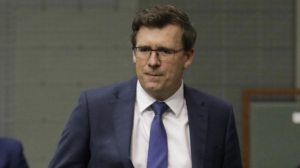Home » Commentary » Opinion » Education reform starts at the end; student outcomes
· The Australian
 It’s taken 20 years to trash the education system, but the newly minted federal Education Minister this week set an ambitious 10-year turnaround goal for Australian students to once again be among the world’s highest performers.
It’s taken 20 years to trash the education system, but the newly minted federal Education Minister this week set an ambitious 10-year turnaround goal for Australian students to once again be among the world’s highest performers.
In his first major address on schooling, Alan Tudge announced reforming teaching quality, curriculum and assessment as his priorities in delivering improvement. He’s flagged a new review to help chart the course.
But, while he identifies the right priorities, he must also take an outcomes-based approach — often lacking in education policy — to truly be a turnaround minister in what is a notoriously high-turnover portfolio. That will put him at odds with a sector that’s routinely fixated on what’s put in rather than what comes out.
While it’s true some predecessors have left meaningful legacies on schooling, few can genuinely boast of delivering sharp improvements to education outcomes.
On the ALP’s side, Julia Gillard delivered NAPLAN, providing nationally consistent assessment and reporting. And on the LNP’s side, David Kemp brought greater competition to schooling, delivering parents more choice than in most countries.
But other ambitious aims haven’t always translated to better outcomes. For instance, the Building the Education Revolution and Digital Education Revolution were costly blunders and ripe examples of solutions in search of problems. Gonski reform entrenched a flawed and expensive funding model that’s focused on redistributing inputs, and has precious little to do with improving outcomes.
But that mustn’t deter Canberra from advancing national leadership for today’s much-needed reform efforts. There’s no hiding from the fact we have a national problem that demands a national solution. Student achievement in the OECD-run Program for International Student Assessment has collapsed more quickly and consistently than any other country except Finland.
Aligning the turnaround mentality to curriculum, assessment and teaching quality — rather than seeing them as standalone priorities — will be needed to shift the gears within the sector.
The minister must avoid the trap of seeing curriculum reform as a one-stop shop for educational improvement.
It’s easy to become weighed down by the inevitable battlegrounds over content and suffer tunnel-vision on inputs rather than outcomes. The circus concerning reform of the national maths curriculum is a case in point, as is the NSW government’s ill-conceived flirtation with overzealous progressive redesign of curriculum. Similarly, quick fixes attempting to import overseas curriculums are shortsighted and ignore the bigger picture. Ultimately, it’s delivery of curriculum more than development of curriculum that is critical to the turnaround goal. Achieving improvement demands articulating — and gaining support for — a vision for how curriculum will improve teaching content, rather than simply shuffling deckchairs while the education ship sinks.
The steadfast commitment to retaining, while refining, NAPLAN is welcome, but must be matched with how higher standards will translate to classrooms. A recent review of NAPLAN, and another of the supporting MySchool website, show they broadly work as resources to educators and parents, but there can be a disconnect with student outcomes.
Leading a national conversation about using NAPLAN, among other tools, to drive performance will make a lasting improvement to education. Tudge can take a leaf from the book of NSW Education Minister Sarah Mitchell in establishing benchmark outcomes for schools and delivering accountability that’s lacking; particularly for parents who have few options in picking between schools.
Yet, the pachyderm in the classroom inevitably boils down to teaching quality. Attempts in recent years to define expectations of teachers have flopped, largely because it’s been inwardly focused on professional practice more than on teaching delivery and students’ outcomes.
Workforce strategy is needed to improve flexibility, responsiveness, accountability and expertise in the teaching profession. This requires a shake-up to a stagnant workforce that is rigid, resistant to change, unaccountable and evidence-rejecting.
There should be little doubt whether we can reach the goal of being among the best performers in education, since not so long ago we already were. But reversing the trend is a major undertaking and one where few friends will be won within the sector. Ambitious national leadership in education is timely and much-needed.
Education reform starts at the end; student outcomes